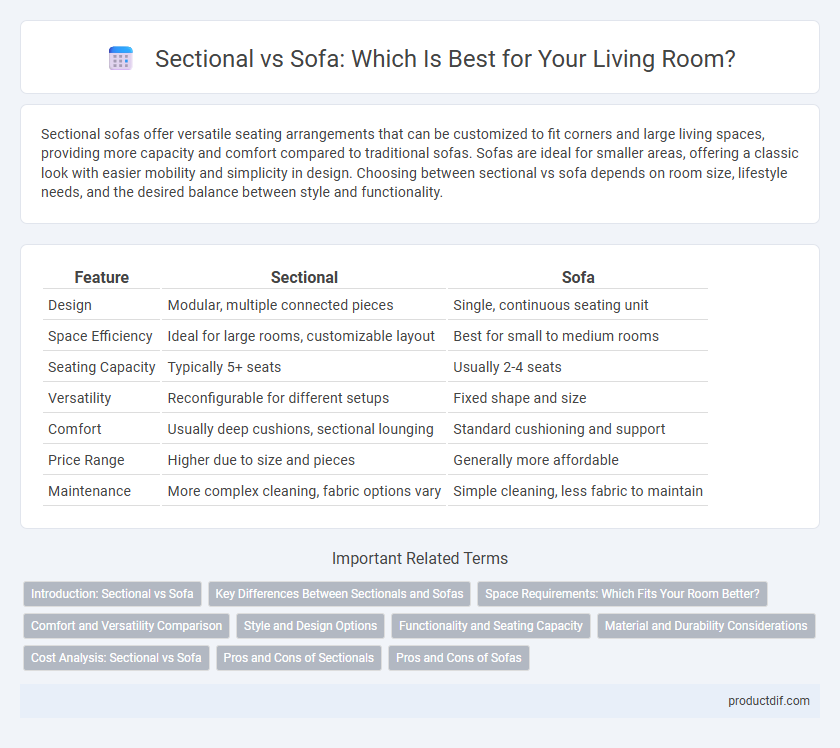Sectional sofas offer versatile seating arrangements that can be customized to fit corners and large living spaces, providing more capacity and comfort compared to traditional sofas. Sofas are ideal for smaller areas, offering a classic look with easier mobility and simplicity in design. Choosing between sectional vs sofa depends on room size, lifestyle needs, and the desired balance between style and functionality.
Table of Comparison
| Feature | Sectional | Sofa |
|---|---|---|
| Design | Modular, multiple connected pieces | Single, continuous seating unit |
| Space Efficiency | Ideal for large rooms, customizable layout | Best for small to medium rooms |
| Seating Capacity | Typically 5+ seats | Usually 2-4 seats |
| Versatility | Reconfigurable for different setups | Fixed shape and size |
| Comfort | Usually deep cushions, sectional lounging | Standard cushioning and support |
| Price Range | Higher due to size and pieces | Generally more affordable |
| Maintenance | More complex cleaning, fabric options vary | Simple cleaning, less fabric to maintain |
Introduction: Sectional vs Sofa
Sectional sofas offer versatile seating arrangements by combining multiple sections to fit various room layouts, ideal for larger spaces or family gatherings. Traditional sofas provide a compact, single-piece design that suits smaller rooms and promotes a classic aesthetic. Choosing between a sectional and a sofa largely depends on space availability, desired seating capacity, and interior style preferences.
Key Differences Between Sectionals and Sofas
Sectionals consist of multiple connected pieces, allowing for customizable seating arrangements, whereas sofas are typically single, unified units with a fixed shape. Sectionals often provide more seating capacity and can be tailored to fit various room layouts, while sofas generally suit smaller spaces with classic designs. The modular nature of sectionals offers versatility, contrasting with the simplicity and traditional style of standard sofas.
Space Requirements: Which Fits Your Room Better?
Sectionals typically require more floor space due to their L-shaped or U-shaped design, making them ideal for larger living rooms or open floor plans. Sofas, being more compact and linear, fit well in smaller rooms or apartments where space optimization is crucial. Choosing between a sectional and a sofa depends on your room size, layout, and how much seating you need without overcrowding the space.
Comfort and Versatility Comparison
Sectionals provide enhanced comfort through adjustable seating options and ample space for multiple users, making them ideal for larger living areas. Sofas typically offer a more compact design that suits smaller rooms while maintaining ergonomic support and style. Versatility in sectionals comes from modular components allowing reconfiguration, whereas sofas prioritize simplicity and ease of placement.
Style and Design Options
Sectionals offer versatile style and design options with modular pieces that can be rearranged to fit various room shapes and sizes, making them ideal for customizable seating arrangements. Sofas come in a wide range of traditional and contemporary designs, often emphasizing streamlined shapes and a uniform look that complements diverse decor styles. Both sectional and sofa selections feature an array of materials, colors, and patterns, allowing seamless integration with modern, rustic, or classic interior themes.
Functionality and Seating Capacity
Sectionals offer versatile seating arrangements with multiple modular pieces, ideal for accommodating larger groups and creating customizable layouts. Sofas typically provide a fixed seating capacity, usually seating three to five people, making them more suited for smaller spaces or simpler room designs. The choice between sectional and sofa depends on the need for flexibility in seating and the available room size.
Material and Durability Considerations
Sectionals often feature durable fabrics like microfiber or leather that resist stains and wear, making them ideal for high-traffic areas. Sofas typically come in a variety of materials such as linen, velvet, or synthetic blends, which may offer less resistance to daily use but provide more style flexibility. When prioritizing longevity, leather and tightly woven synthetic fabrics used in sectionals generally outperform softer sofa materials due to better abrasion resistance and ease of cleaning.
Cost Analysis: Sectional vs Sofa
Sectionals often have a higher initial cost compared to standard sofas, with prices averaging between $1,000 and $3,000 depending on size and materials, while sofas typically range from $500 to $1,500. The modular nature of sectionals allows for flexible configurations, potentially reducing the need for additional furniture and long-term expenses. Maintenance and upholstery replacement costs should also be considered, as sectionals can incur higher upkeep due to their larger surface area.
Pros and Cons of Sectionals
Sectional sofas offer customizable seating arrangements that maximize space, making them ideal for large living rooms or family gatherings, but their size can overwhelm smaller spaces and limit flexibility in room layout. They provide ample seating and comfort with modular components that can be rearranged, yet the complexity of moving or reconfiguring a sectional can be challenging due to its bulky nature. Sectionals often come with storage options and recliners, enhancing functionality, but tend to be more expensive and harder to clean compared to traditional sofas.
Pros and Cons of Sofas
Sofas offer versatile seating options with various styles and sizes that fit well in most living spaces, providing comfort and aesthetic appeal. Their compact design typically allows easier placement and rearrangement compared to sectionals, making them ideal for smaller rooms or apartments. However, sofas offer less seating capacity and flexibility than sectionals, potentially limiting accommodation for larger gatherings.
Sectional vs Sofa Infographic

 productdif.com
productdif.com